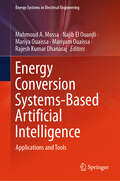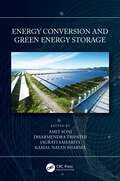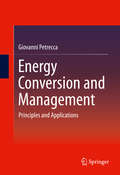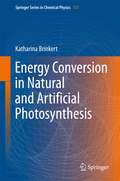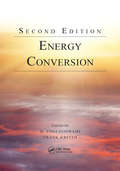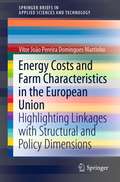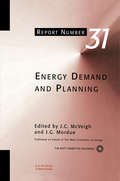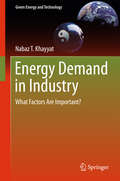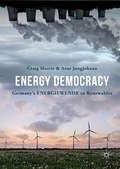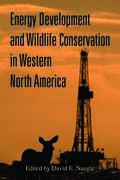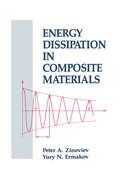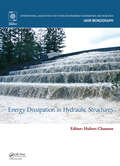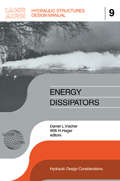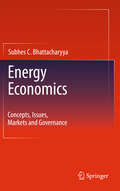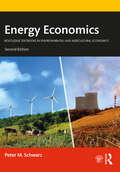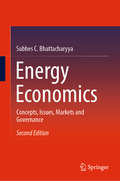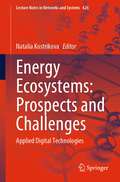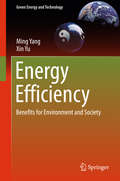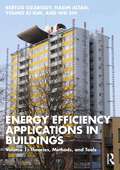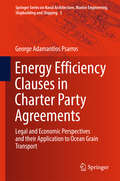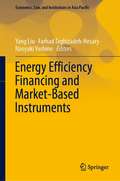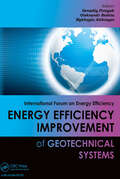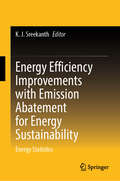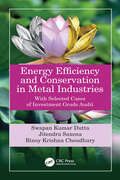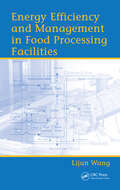- Table View
- List View
Energy Conversion Systems-Based Artificial Intelligence: Applications and Tools (Energy Systems in Electrical Engineering)
by Mariya Ouaissa Mariyam Ouaissa Rajesh Kumar Dhanaraj Mahmoud A. Mossa Najib El OuanjliThis book aims to propose advanced solutions based on artificial intelligence techniques for ECS in order to increase energy efficiency, ensure the safety of the ECS, and to improve the quality of the energy supplied to the grid. The efficiency and quality of the electrical energy produced depends mainly on the structure and efficiency of the control technology developed for the Energy Conversion System (ECS). To improve the performance of ECSs, it is interesting to design control systems that emulate some functions performed by the human brain. Among these interesting functions are self-adaptation, learning, flexibility of operation and planning in the presence of large uncertainties and with minimal information. Based on these aspects, artificial intelligence (AI) techniques can be developed and applied to solve the different control problems of ECSs. For academics, professionals, practitioners, and graduate students interested in the most recent research on the application of AI in ECS, it is the ideal reference source.
Energy Conversion and Green Energy Storage
by Amit SoniEnergy Conversion and Green Energy Storage presents recent developments in renewable energy conversion and green energy storage. Covering technical expansions in renewable energy and applications, energy storage, and solar photovoltaics, the book features chapters written by global experts in the field. Providing insights related to various forms of renewable energy, the book discusses developments in solar photovoltaic applications. The book also includes simulation codes and programs, such as Wien2k code, VASP code, and MATLAB®. The book serves as a useful reference for researchers, graduate students, and engineers in the field of energy.
Energy Conversion and Management
by Giovanni PetreccaThis book provides an overall view of energy conversion and management in industry and in buildings by following the streams of energy from the site boundaries to the end users. Written for an audience of both practitioners and faculty/students, Energy Conversion and Management: Principles and Applications presents general principles of energy conversion and energy sources, both traditional and renewable, in a broad range of facilities such as electrical substations, boiler plants, heat and power plants, electrical networks, thermal fluid distributions lines and insulations, pumps and fans, air compressor systems, cooling plants, HVAC, lighting, and heat recovery plants. The book also examines principles of energy auditing and accounting, the correlation between energy and environment, and includes detail on the economic analysis of energy saving investment and education in the field of energy. This book also: · Explores a broad array of power generation and distribution facilities around the concept of energy conversion, from traditional and renewable sources, correlating many apparently disparate topics · Elucidates fundamental formulas and information-rich figures to help readers in solving any practical energy conversion problems · Emphasizes a holistic perspective on energy conversion and management with a vision of each application as a system beyond its individual elements · Includes a set of Key Performance Index using metrics applicable to energy systems brought into operation over the past 30 years · Gives a set of basic formulas and data that are the essentials of energy conversion and that everybody involved in these fields should perfectly know · Adopts a writing style accessible to technicians and managers in the field of energy conversion while maintaining sufficient rigor and coverage for engineers
Energy Conversion in Natural and Artificial Photosynthesis (Springer Series in Chemical Physics #117)
by Katharina BrinkertThis book discusses the basic principles and processes of solar energy conversion in natural photosynthesis. It then directly compares them with recent developments and concepts currently being pursued in artificial photosynthetic systems that are capable of utilizing sunlight to convert carbon dioxide and water into a chemical fuel. In this regard, the main focus is on photoelectrochemical cells, in which semiconducting photoanodes and -cathodes modified with (electro-) catalysts are used to oxidize water, produce hydrogen and reduce carbon dioxide in a monolithic device. The fundamental photochemical and photophysical processes involved are presented and discussed, along with protection mechanisms and efficiency calculations for both natural and artificial photosynthesis. In turn, key parameters that are crucial for the efficient operation of natural photosynthesis are identified. Lastly, their validity and applicability in the design of artificial solar-driven water-splitting systems are examined.
Energy Conversion, Second Edition
by D. Yogi Goswami Frank KreithThis handbook surveys the range of methods and fuel types used in generating energy for industry, transportation, and heating and cooling of buildings. Solar, wind, biomass, nuclear, geothermal, ocean and fossil fuels are discussed and compared, and the thermodynamics of energy conversion is explained. Appendices are provided with fully updated data. Thoroughly revised, this second edition surveys the latest advances in energy conversion from a wide variety of currently available energy sources. It describes energy sources such as fossil fuels, biomass (including refuse-derived biomass fuels), nuclear, solar radiation, wind, geothermal, and ocean, then provides the terminology and units used for each energy resource and their equivalence. It includes an overview of the steam power cycles, gas turbines, internal combustion engines, hydraulic turbines, Stirling engines, advanced fossil fuel power systems, and combined-cycle power plants. It outlines the development, current use, and future of nuclear power.
Energy Costs and Farm Characteristics in the European Union: Highlighting Linkages with Structural and Policy Dimensions (SpringerBriefs in Applied Sciences and Technology)
by Vítor João MartinhoThis book explores the relationships between the energy costs and other farm variables in the European Union (including the UK) over a recent period of six years. It examines labour, farm land area, outputs/inputs, investments, assets, taxes, and subsidies in the context of policy measures and the farm structure. The book provides a deep insight into how energy cost and other factors in the farming sector relate to each other and as a result how farm planning can be made more efficient, more environmentally sustainable and more competitive. It will be of interest to policy-makers, governments, researchers and advanced students of economics, policy and the environment.
Energy Demand and Planning
by J. C. McVeigh J. G. MordueEnergy, Demand and Planning brings together a group of distinguished authors from many relevant disciplines, under the auspices of the Watt Committee on Energy. The authors were asked to consider the effects of policy decisions that might be taken now on the planning of the world energy industries in the coming half-century or so. Discussion is hel
Energy Demand in Industry
by Nabaz T KhayyatThe book presents a stochastic analysis based on production risk and application of this method in the industrial sector under production risk where energy use is an input factor. Using South Korea as a case study, the book empirically models energy demand at the industrial level and analyzes the results to identify key determinants of energy demand, productions level, productions risk and energy usage efficiency. Particular attention is paid to the factors that enhance production risk or increase variations in energy input during production. A dynamic panel model is specified and applied to 25 Korean industrial sectors over the period 1970-2007. The determinants of energy usage are identified and their effects in the form of elasticities of energy usage are estimated. In addition the structural changes in the energy demand pattern are explored. Stochastic production technology is applied to create two primary models: A production model where the energy usage is a determinant of output and an energy demand model based on an inverted factor demand model where demand is a key determinant of the level of energy usage. The findings reveal that: First, there are large variations in the degree of overuse or inefficiency in energy usage among the individual industries and over time; second, ICT (information and communication technology) capital and labor are substituting energy; third, ICT capital and value added services are two input factors decreasing the variability of energy demand while non-ICT capital, material and labor are increasing the variability of energy demand. Finally, the results suggest that technical progress contributes more to the increase of mean of energy demand than to the reduction of the level of risk. An emerging recommendation is that industries increase the level of ICT capital and digitalization and invest more in R&D activities and value added services to reduce the uncertainty related to their demand for energy. This study forms the structure of the demand for energy under stochastic production risk for the South Korean industrial sector. Public research programs aimed at the industrial sector should be concerned about both mean and risk properties in research on new technologies and in the investigation of possible alternative energy inputs. This book describes the state of the art in energy usage analysis and production risk, applying factor requirement methodology. It will be of use as a main or supplementary text in the teaching of advanced graduate courses but also as a reference for those working on empirically advanced research. The book is an important addition to the existing literature on industrial development, with its focus on energy as a core production input.
Energy Democracy
by Craig Morris Arne JungjohannThis book outlines how Germans convinced their politicians to pass laws allowing citizens to make their own energy, even when it hurt utility companies to do so. It traces the origins of the Energiewende movement in Germany from the Power Rebels of Schönau to German Chancellor Angela Merkel's shutdown of eight nuclear power plants following the 2011 Fukushima nuclear accident. The authors explore how, by taking ownership of energy efficiency at a local level, community groups are key actors in the bottom-up fight against climate change. Individually, citizens might install solar panels on their roofs, but citizen groups can do much more: community wind farms, local heat supply, walkable cities and more. This book offers evidence that the transition to renewables is a one-time opportunity to strengthen communities and democratize the energy sector - in Germany and around the world.
Energy Development and Wildlife Conservation in Western North America
by David E. NaugleEnergy Development and Wildlife Conservation in Western North America offers a road map for securing our energy future while safeguarding our wildlife heritage. Contributors show how science can help craft solutions to conflicts between wildlife and energy development by delineating core areas, identifying landscapes that support viable populations, and forecasting future development scenarios to aid in conservation design. The book calls for a shift away from site-level management that has failed to mitigate cumulative impacts on wildlife populations toward broad-scale planning and implementation of conservation in priority landscapes. It concludes by identifying ways that decision makers can remove roadblocks to conservation, and provides a blueprint for implementing conservation plans.
Energy Dissipation in Composite Materials
by Peter A. Zinoviev Yury N. ErmakovAll real materials in one way or another, exhibit a departure from ideal elastic behaviour, even at very small strain values. Under cyclic deformation, these departtures result in irreversible energy losses in material. The causes of such losses are many, and include the irreversible transfer of mechanical energy into heat, growth of cracks and other defects, and the microplastic deformaton of crystals to name a few. Several terms have been suggested to define these phenomena including damping, energy dissipation, imperfect elasticity and internal friction. This book is about materials damping; with damping or energy dissipation processes in vibrating solids.
Energy Dissipation in Hydraulic Structures (IAHR Monographs)
by Peter A. DaviesRecent advances in technology have permitted the construction of large dams, reservoirs and channels. This progress has necessitated the development of new design and construction techniques, particularly with the provision of adequate flood release facilities. Chutes and spillways are designed to spill large water discharges over a hydraulic struc
Energy Dissipators: IAHR Hydraulic Structures Design Manuals 9 (Iahr Design Manual Ser. #9)
by W.H. HagerEnergy dissipators are an important element of hydraulic structures as transition between the highly explosive high velocity flow and the sensitive tailwater. This volume examines energy dissipators mainly in connection with dam structures and provides a review of design methods. It includes topics such as hydraulic jump, stilling basins, ski jumps and plunge pools. It also introduces a general account of various methods of dissipation, as well as the governing flow mechanisms.
Energy Economics
by Subhes C. BhattacharyyaSince its modest beginning in the 1970s, the academic and research focus on energy has grown substantially and energy has established itself as an independent, interdisciplinary subject area. It attracts attention from people in a range of different fields including engineers, scientists, geologists, environmentalists, bankers, investors, policy makers and politicians. Energy Economics introduces the basic concepts of energy economics and explains how simple economic tools can be used to analyse contemporary energy issues. Energy Economics is organised into six parts that give the reader a thorough grounding in various key aspects of the subject: basic demand-related concepts and ideas used in energy economics; supply-side economics;energy markets, with specific emphasis on oil, gas and coal;the application of simple economic principles in analysing contemporary energy issues;environmental aspects of energy use; andregulatory and governance issues. Energy Economics is an easily accessible reference book for students of energy economics at the postgraduate level, as well as for a wider interdisciplinary audience. It provides readers with the skills required to understand and analyse complex energy issues from an economic perspective.
Energy Economics (Routledge Textbooks in Environmental and Agricultural Economics)
by Peter M. SchwarzEnergy Economics outlines the fundamental issues and possible solutions to the challenges of energy production and use, presenting a framework for decisions based upon sound economic analysis. This approach considers market forces and policy goals, including economic prosperity, environmental protection, and societal well-being. The second edition has been thoroughly updated, addressing dramatic shifts in the use of fuel and electricity, accelerated plans for the use of renewable energy, and pathways towards a lower-carbon future. A new chapter on electric vehicles examines its impact on transportation, the electricity market, and carbon emissions. Global examples throughout the book reflect the universal application of energy economics. With this economic foundation, coupled with perspectives from real-world applications, and perspectives from related disciplines, this text sharpens the student’s ability to understand, evaluate, and critique energy policy. A companion website provides reinforcement for students through multiple choice self-test quizzes and homework exercises, as well as additional materials for instructors. This textbook should be essential reading for students of energy economics, environmental and natural resource economics, energy-related disciplines, and general readers seeking to expand their knowledge of energy economics and policy.
Energy Economics: Concepts, Issues, Markets and Governance
by Subhes C. BhattacharyyaThis book provides an updated and expanded overview of basic concepts of energy economics and explains how simple economic tools can be used to analyse contemporary energy issues in the light of recent developments, such as the Paris Agreement, the UN Sustainable Development Goals and new technological developments in the production and use of energy. The new edition is divided into four parts covering concepts, issues, markets, and governance. Although the content has been thoroughly revised and rationalised to reflect the current state of knowledge, it retains the main features of the first edition, namely accessibility, research-informed presentation, and extensive use of charts, tables and worked examples.This easily accessible reference book allows readers to gain the skills required to understand and analyse complex energy issues from an economic perspective. It is a valuable resource for students and researchers in the field of energy economics, as well as interested readers with an interdisciplinary background.
Energy Ecosystems: Applied Digital Technologies (Lecture Notes in Networks and Systems #626)
by Natalia KostrikovaThis book aims to review the key areas of modern research in power engineering regarding environmental conservation, as well as the research and development of digital technologies in the energy sector.The main result of fruitful work within the framework of the III International Conference "Energy Ecosystems: Prospects and Challenges: Applied Digital Technologies" has become this book, which includes 16 best reports on priority issues of modern energy development.The book is of interest to scientists, students, researchers, representatives of energy companies, representatives of leading Russian and European universities, and research institutes. We feel confident that our book will serve as an important source of information and knowledge that will lead to scientific and innovative progress in the field of sustainable development of the society.
Energy Efficiency
by Ming Yang Xin YuThis book discusses how energy efficiency benefits the global environment, national energy security, local pollution mitigation, natural resource conservation, and utility bill reduction. In addition, this book provides many hands-on skills and knowledge to identify and develop energy efficiency projects. The literature review shows that energy efficiency has become the first fuel in the world energy supply. With empirical analyses, this book indicates that without continued investment in energy efficiency, neither China nor the U. S. could achieve their carbon emission reduction targets that were announced on November 13, 2014 during the Beijing 2014 APEC meeting. The authors argue that energy efficiency will become the first tool to mitigate climate change. These include (1) identifying energy efficiency barriers, (2) developing energy policies, (3) investing in energy efficient technologies, (4) undertaking project cost-effectiveness analysis, (5) de-risking and financing energy efficiency projects; (6) developing and managing energy service companies, and (7) promoting urban transport efficiency. Two case studies in energy efficiency improvement in electrical motors and industrial boilers are also presented. This book is written for college and university students, practitioners, researchers, consultants, project developers, and policy makers who want to dedicate their professional careers in global energy efficiency improvement, climate change mitigation, local clean air initiatives, and energy bill reduction.
Energy Efficiency Applications in Buildings: Volume 1: Theories, Methods, and Tools
by Wei Shi Bertug Ozarisoy Hasim Altan Young Ki KimEnergy Efficiency Applications in Buildings presents an investigation into the energy use and measures to improve the energy efficiency of existing building stock in the UK. The aim of this research is to assess the domestic energy use of statistically representative residential buildings and their occupants’ thermal comfort by considering the significant impact of overheating risks on energy consumption and occupants’ well-being.Divided into two volumes, these books present energy consumption and thermal comfort in the construction sector as a complex socio-technical problem that involves the analysis of an intrinsic interrelationship amongst dwellings, occupants, and the environment. Using case studies, the authors demonstrate the significance of improving energy efficiency and its impact on occupants during long-term heatwaves in the summer. Additionally, the volumes demonstrate how dynamic thermal energy simulation can be used as a learning laboratory for future trends in housing energy consumption reduction.Volume 1: Theories, Methods, and Tools presents the background to the research and the assessment methods and tools adopted by the research team.Volume 2: Performance Evaluation and Retrofitting Strategies describes the case studies and building performance and post-occupancy evaluations, before making strategic policy and retrofitting recommendations.The research and roadmap presented in these volumes can be used as a guidance tool for building energy modelling and performance simulation, enabling architects, building engineers, and other practitioners to close the gap between the current understanding and the actual performance of existing building stocks.
Energy Efficiency Clauses in Charter Party Agreements
by George Adamantios PsarrosThis book provides practical solutions for addressing energy efficiency as a clause term within a charter party contract. For this, upon a reflection of the regulatory craft, it analyzes key concepts of case law, and discusses them together with commercial and economic principles. In this way, the book aims at offering a comprehensive, interdisciplinary view of the chartering process, together with a new approach for safeguarding energy efficiency investments. A special emphasis is given to the maritime industry. Here, the newly developed framework, based on game theory, has been successfully applied to demonstrate the importance of including a clause term in contract negotiation to achieve protection against both an uncertain market and an even more challenging shipping environment. The book not only fills a gap in the literature, covering a topic that has been largely neglected to date, yet it offers researchers and practitioners extensive information to change the chartering process radically.
Energy Efficiency Financing and Market-Based Instruments (Economics, Law, and Institutions in Asia Pacific)
by Yang Liu Naoyuki Yoshino Farhad Taghizadeh-HesaryThis book is devoted to investigating the policy design and effectiveness of financial and market-based instruments to promote energy efficiency financing. The concept of this monograph is to present the latest results related to energy efficiency funding schemes, energy efficiency obligations, voluntary agreements, auction mechanisms, and Super Energy Services Companies (Super ESCOs) in major jurisdictions across the world. The book focuses on financial and market-based instruments as they deliver a price signal, which provides an incentive for firms to invest in innovation or implement more energy-efficient technologies and deliver energy savings while minimizing costs. Such instruments can have significant advantages for the government, supporting the fiscal sustainability of the government’s energy efficiency efforts, requiring less enforcement than regulation and according the market flexibility to select the most cost-efficient technologies. This book is highly recommended to researchers, policy experts, and business specialists who seek an in-depth and up-to-date integrated overview of energy efficiency financing.
Energy Efficiency Improvement of Geotechnical Systems: International Forum on Energy Efficiency
by Genadiy Pivnyak Mykhaylo Alekseyev Oleksandr BeshtaThis book covers innovative technologies and approaches for improvement of technical and economic parameters of functional geotechnical systems. The focus is on mathematical modelling of objects and processes, as well as the development of techniques and their control algorithms. The book comprises schemata of practical tasks solving related to min
Energy Efficiency Improvements with Emission Abatement for Energy Sustainability: Energy Statistics
by K. J. SreekanthThe book titled “Energy Efficiency Improvements with Emission Abatement for Energy Sustainability” targets primarily academicians and policy-makers who are involved and practiced in the energy and environment field. It is useful for students, scholars, who wish to obtain an inclusive impression, and those with advanced knowledge can obtain a deeper knowledge of specific issues related with energy statistics, emission reduction and sustainability. Policy-makers in international organizations, national & local governments, companies & trade associations, and NGOs can use it as a source of inspiration for future policymaking as well as for a better understanding about the consumer behavior while dealing with energy. The book obviously targets those interested in energy and associated aspects, its setbacks, though there may be close parallels with social and behavioral issues. While its scope is international, this book may also be relevant to readers concerned with domestic areas of precise country and continental interest, as these are increasingly uncovered to developmental issues in energy. The book addresses the following major aspects: • The energy statistics assessment for energy sustainability with an emission abatement approach. • The relationship between energy statistics and major greenhouse gas emissions, explained in the energy efficiency context. • The relevant policy directions in the energy statistics direction. • The impact of climate change, and its effect on various sectors/countries and the role of energy statistics on them. Those who are interested in the interpretation of statistical data on energy resources and pollution, latest innovations in energy markets, energy technology and services, carbon mitigation, can make this book useful.
Energy Efficiency and Conservation in Metal Industries: With Selected Cases of Investment Grade Audit
by Swapan Kumar Dutta Jitendra Saxena Binoy Krishna ChoudhuryThis book provides a deep insight into the energy usage in the energy intensive metal industry and the methodology for efficiency assessment. Various methodologies for energy audits are described, along with concept-level analysis for minimum energy design. Apart from the technical and engineering analysis, the book also describes management aspects such as energy management systems and financial, environmental and social analysis leading to the development of a comprehensive plan for implementation of energy efficiency and conservation in industries. Barriers to investment in energy efficiency and conservation are discussed, based on review of global and Indian case studies. FEATURES: Details fundamental principles driving energy consumption in an industrial set-up backed with illustrative examples Explains various alternative methods for discovery of energy efficiency and conservation projects. Focusses on metal-producing and -processing facilities with an emphasis on environmental quality Supports maximum digitalization of energy audit assessment and report preparation processes Includes global case studies and tutorials at the end of the corresponding chapters This book is useful for researchers, professionals and graduate students in thermodynamics, manufacturing, thermal engineering, energy engineering, energy efficiency and energy processes, especially in the metal industry.
Energy Efficiency and Management in Food Processing Facilities
by Lijun WangEnergy efficiency, environmental protection, and processing waste management continue to attract increased attention in the food processing industry. As with other industrial sectors, reducing costs while also reducing environmental impact and improving overall sustainability is becoming an important part of the business process. Providing practica
